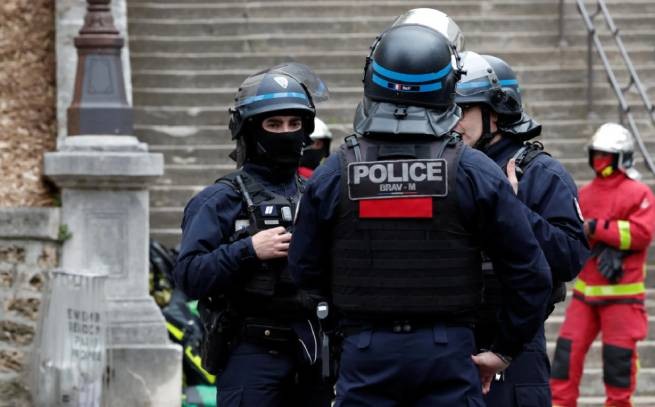As seismologists explain, over the years of the existence of instrumental measurements in Greece, an earthquake of such strength as that occurred on September 27, with a focus that was not at the bottom of the sea, was not recorded.
Greece is located in an active seismic zone, and the island of Crete, together with Rhodes, and even more so, in fact, being part of the so-called. non-volcanic “Greek arc”.
The “Greek Arc” is located in an area that is highly vulnerable to seismic activity and has historically always been exposed to the impact of the subterranean elements.
Seismologist Gerasimos Papadopoulos describes this earthquake as “an earthquake that will go down in history.” He points out that this is, in fact, the first earthquake of this magnitude, which was recorded in the area of Crete with the help of instruments. “We now have historical experience as we know that there are no earthquake-proof areas in Greece,” explains Mr Papadopoulos.
He even recalls that a much stronger earthquake was recorded in May 2020 – with a magnitude of 6.6 on the Richter scale – centered in the offshore region of Ierapetra, but there were no casualties or destruction.
However, the recent earthquake that struck Arkalohori was not only anticipated by seismologists due to the activity that began in the summer months, but also recommended the full implementation of the Egelados operational plan, which includes informing residents, taking practical measures, identifying hazards and updating emergency plans. …
Mr Papadopoulos commented: “In early June, we had continuous seismic activity in the same area. For this reason, the OASP Seismic Risk Assessment Committee, of which I am a member, held an emergency meeting on July 21, chaired by Professor Efthymios Lekkas and decided that:
a stronger earthquake is not excluded compared to what happened before, i.e. 4.4 points on the Richter scale;
preventive measures must be fully implemented by the competent services. “
Although the magnitude of the earthquake expected by seismologists has not been determined, the recommendation to activate the Ekelados plan is usually given when it is assumed that there is a risk of seismic shocks greater than 5 on the Richter scale.
In addition, according to Papadopoulos, in the case of Crete, “nature has warned.” As for the fault that caused the strong earthquake, it has been little studied, but is now considered fully confirmed.
According to experts, this is probably the main earthquake, but they also expect that the passage of the first 72 hours will adequately study the sequence of aftershocks up to 5.3 points.
The largest earthquake in the history of Crete happened centuries ago. It was so strong that it caused innumerable destruction, tsunamis, and an uplift of its western side by 9 meters.
According to ancient historians, it happened on July 21, 365 AD, with a focus off the coast of western Crete. The earthquake was rated between 8.3 and 8.7 on the Richter scale, making it the strongest earthquake ever recorded in the Mediterranean.
The earthquake caused great damage to central and southern Greece, Libya, Asia Minor and Egypt. Almost all the cities of Crete were destroyed. The earthquake was followed by a tsunami that damaged the Eastern Mediterranean, especially in the Nile Delta and Alexandria, killing thousands and reaching nearly three kilometers inland. In the southwest of Crete, the wave height from the earthquake is estimated at 12 meters.
Wave heights were high in the Nile Delta, where it was estimated to be 9.5 meters in Alexandria and 7.1, 4.9 and 2 meters in neighboring cities. In Alexandria, the waters first receded, and the inhabitants of the city rushed to fish and sea creatures where there used to be a sea. But after a short time, the sea returned back at such a speed that large ships were thrown onto the roofs of houses, while some ships were discovered almost three kilometers from the coast.
According to modern estimates, the seismic moment was ~ 10 ^ 29 dyn cm. Earthquakes of this magnitude in this region are more did not happenand.
Regions hardest hit by the tsunami
Researchers from the University of Cambridge, based on radiocarbon studies, have identified corals off the coast of Crete, which were raised to a height of 10 meters and pressed into solid rock by a mass of water. This means that the tsunami after the 365 year earthquake occurred as a result of the bending of the Greek arc near Crete. Experts note that such large-scale undersea earthquakes occur about once every 5,000 years, but other segments can also cause similar shifts and occur about once every 800 years. In any case, a recurrence of these events in the future cannot be ruled out.
Raised structures 2 km west of Paleochora showing changes caused by waves up to 9 m high during the 365 year earthquake
It is noted that this earthquake raised western Crete up to 9 meters. It had a great influence on people at the end of the antique period and is mentioned in a large number of works by various authors.
Ammianus Marcellinus estimated that about 10,000 people died in Alexandria alone.
The ancient Roman historian Ammianus Marcellinus described in detail the tsunami that struck Alexandria and other areas in the first hours of July 21, 365.
Delta of the Nile. Source wikimedia
Of particular value are the evidence of three tsunami phases, namely, the initial earthquake, the unexpected retreat of the sea and then a giant wave that swept across the island:
Immediately after the night passed and clearly proclaimed the succession of the day with fierce lightning, the strength of the earth shook – it began to tremble and shake. Then the sea retreated, but the waves quickly returned so that everything disappeared into chaos and the depths of the sea. Many creatures belonging to the sea were thrown onto land, covering everything with slime, garbage and debris covered the valleys and mountains completely. Everything that was created, all values became the prey of the elements. All this happened at the same time. It was impossible to believe in it, looking at the first rays of the sun of a new day. Many ships were washed ashore far enough, and the people who wandered along this coast were so insignificant – many were collecting fish and stuff that was thrown onto land. The raging sea seemed to be offended and returned again, and the land was shown by the dotted shoals that are found in abundance. It rolled onto the islands in a wide stream, flattening myriad buildings in cities and elsewhere. Thus, a conflict of elements arose, showing that the earth can change and give miraculous signs. The mass of water that returned killed many thousands – they drowned; those who hastily grabbed onto something heavy were thrown back. Some ships, after the wrath of the elements, turned into a pile of boards and sank, and the bodies of those killed in the shipwreck lay face down or face up. Other large ships seemed to have been displaced by horrific explosions, ending up on the roofs of houses, as happened in Alexandria. Elsewhere, they were found two miles from the coastline, such as the Laconian ship near Methoni, which I saw as I passed by, yawning at the long sight of desolation.
The tsunami of 365 was so devastating that the annual anniversary of the disaster was remembered as a “day of horror” in Alexandria until the end of the 6th century.
Pharos lighthouse (Egyptian Alexandria)
Among the most significant consequences of the tsunami are the destruction of the Pharos lighthouse (Alexandria of Egypt) and the flooding of more than half of the city of Apollonia (Cyrenaica, Libya).
Ruins of ancient Apollonia Libya
According to geophysical data, turbidite deposits were found (in addition to Eastern Sicily) in Malta, in the Ionian Sea, in Cyrenaica, Eastern Calabria and on the western coast of Egypt, and according to historical evidence, the tsunami reached the Iberian Peninsula.
However, despite the power of the earthquake, the largest tsunami in Greece, up to 150 meters high, occurred 1300 years earlier, in 1628 BC, when the supervolcano Santorini exploded. You can read about this in our publication: Geologists have figured out how the explosion of the supervolcano caused the “great flood” in Crete.






More Stories
Poll: which European countries are ready to defend their homeland to the last
K. Mitsotakis announced readiness for the fire season
Greece must transfer the Patriot PAC-3 system to Ukraine with US “guarantees” against the Turkish threat